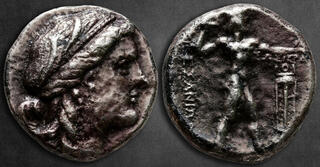| Savoca Numismatik GmbH & Co. KG > Online Auction 203 | Silver | Auction date: 24 March 2024 |
| Lot number: 92 Price realized: 850 EUR (Approx. 923 USD) Note: Prices do not include buyer's fees. | Show similar lots on CoinArchives Find similar lots in upcoming auctions on |
| Lot description: Messenia. Messene circa 183-182 BC. Tetradrachm AR 25 mm, 15,52 g Diademed head of Demeter right, wearing wheat and reed wreath and pearl earring / ΜΕΣΣΑΝΙΩ[Ν], Zeus Ithomatas standing right, hurling thunderbolt with his right hand and with an eagle with spread wings perching on the wrist of his outstretched left arm; below his left arm, ΣΩΣΙΚΑ above a tripod. Very Fine HGC 5, 563; BCD Pel. 710. Ex Solidus Numismatik Auction 27, Lot 152 (smoothed since). Demeter is a prominent deity in ancient Greek mythology, revered as the goddess of agriculture, fertility, and the harvest. She was one of the principal Olympian gods, typically depicted as a mature woman holding sheaves of wheat and bearing a crown or wreath of grain. Demeter's importance in ancient Greek society stemmed from her association with the cultivation of crops, particularly grains like wheat and barley, which were essential staples of the Mediterranean diet. As the goddess of agriculture, Demeter was believed to oversee the growth of crops and ensure the fertility of the earth. Her blessings were sought by farmers and agricultural communities to ensure bountiful harvests and prosperous livelihoods. One of the most famous myths associated with Demeter is the story of her daughter Persephone's abduction by Hades, the god of the underworld. In grief and anger over her daughter's disappearance, Demeter ceased her duties as the goddess of agriculture, causing the earth to wither and crops to fail. This resulted in a devastating famine that threatened humanity. Eventually, a compromise was reached, allowing Persephone to spend part of the year with her mother on earth (spring and summer) and part of the year in the underworld with Hades (autumn and winter). This myth became the basis for the ancient Greek explanation of the changing seasons. Demeter was worshiped throughout ancient Greece, and her festivals, such as the Eleusinian Mysteries, were celebrated with elaborate rituals and ceremonies dedicated to honoring her and seeking her favor. She was often depicted in art and sculpture, sometimes accompanied by symbols of her domain, such as grain, fruits, and agricultural implements. Starting price: 500 EUR |  |


